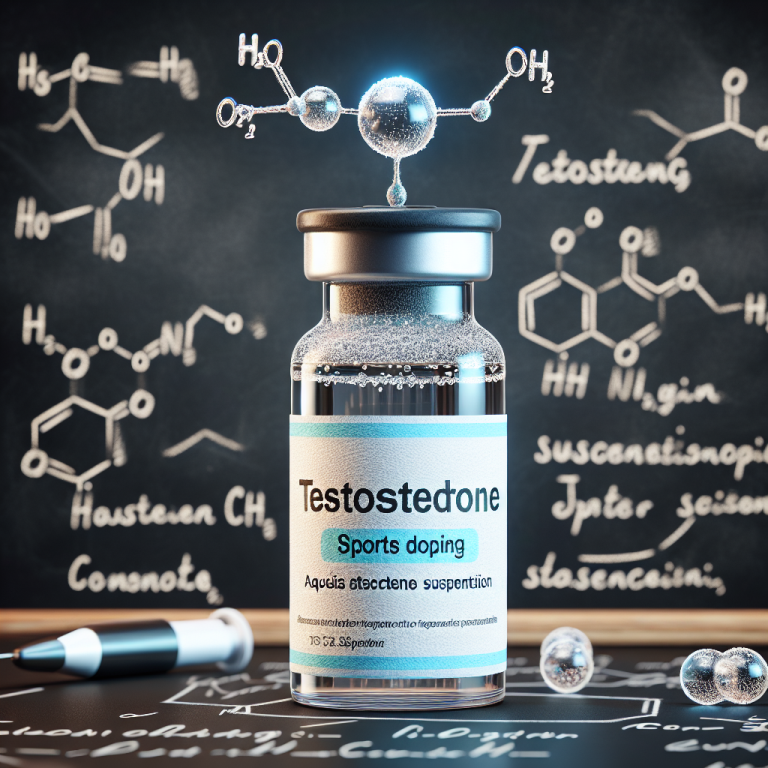-
Table of Contents
- Aqueous Testosterone Suspension in Sports Doping: What You Need to Know
- What is Aqueous Testosterone Suspension?
- Pharmacokinetics of Aqueous Testosterone Suspension
- Pharmacodynamics of Aqueous Testosterone Suspension
- Use of Aqueous Testosterone Suspension in Sports Doping
- Real-World Examples
- Expert Opinion
- Conclusion
- References
Aqueous Testosterone Suspension in Sports Doping: What You Need to Know
Sports doping has been a controversial topic for decades, with athletes constantly seeking ways to gain a competitive edge. One substance that has been at the center of this issue is aqueous testosterone suspension. This form of testosterone has been used by athletes to enhance their performance, but it also comes with potential risks and consequences. In this article, we will explore the pharmacokinetics and pharmacodynamics of aqueous testosterone suspension, its use in sports doping, and the implications for athletes and the sporting community.
What is Aqueous Testosterone Suspension?
Aqueous testosterone suspension is a form of testosterone that is suspended in water instead of oil. It is a synthetic version of the male hormone testosterone, which is responsible for the development of male characteristics such as muscle mass, strength, and endurance. This form of testosterone is typically administered through injection and is known for its fast-acting effects.
Testosterone suspension was first developed in the 1930s and was used medically to treat conditions such as hypogonadism and delayed puberty. However, it was soon discovered that this form of testosterone could also enhance athletic performance, leading to its widespread use in sports doping.
Pharmacokinetics of Aqueous Testosterone Suspension
The pharmacokinetics of aqueous testosterone suspension are unique due to its suspension in water. Unlike other forms of testosterone, which are suspended in oil, aqueous testosterone suspension is rapidly absorbed into the bloodstream, resulting in a quick onset of action. This makes it a popular choice among athletes looking for immediate effects.
Studies have shown that the half-life of aqueous testosterone suspension is approximately 2-4 hours, meaning that it is quickly metabolized and eliminated from the body. This short half-life also means that frequent injections are necessary to maintain high levels of testosterone in the body, which can increase the risk of side effects.
Pharmacodynamics of Aqueous Testosterone Suspension
The pharmacodynamics of aqueous testosterone suspension are similar to other forms of testosterone. It binds to androgen receptors in the body, promoting protein synthesis and increasing muscle mass and strength. It also has anabolic effects, meaning it can enhance athletic performance by increasing endurance and reducing fatigue.
However, the use of aqueous testosterone suspension in sports doping is controversial due to its potential for abuse and side effects. High levels of testosterone in the body can lead to adverse effects such as acne, hair loss, and mood swings. It can also suppress the body’s natural production of testosterone, leading to hormonal imbalances and other health issues.
Use of Aqueous Testosterone Suspension in Sports Doping
Aqueous testosterone suspension is a banned substance in most sports organizations, including the World Anti-Doping Agency (WADA) and the International Olympic Committee (IOC). Its use is considered cheating and can result in severe consequences for athletes, including disqualification, suspension, and loss of medals or titles.
Despite the risks and consequences, some athletes still choose to use aqueous testosterone suspension to enhance their performance. This is often done in combination with other performance-enhancing drugs, known as stacking, to maximize the effects. However, this practice is not only unethical but also dangerous and can have serious health implications.
Real-World Examples
One high-profile case of aqueous testosterone suspension use in sports doping is that of American sprinter Justin Gatlin. In 2006, Gatlin tested positive for testosterone and was banned from competing for four years. He later admitted to using testosterone suspension, among other banned substances, to enhance his performance.
Another example is that of cyclist Lance Armstrong, who was stripped of his seven Tour de France titles after admitting to using performance-enhancing drugs, including testosterone, throughout his career.
Expert Opinion
According to Dr. John Hoberman, a leading expert on sports doping, the use of aqueous testosterone suspension in sports is a serious issue that needs to be addressed. He states, “The use of testosterone suspension in sports is not only cheating but also poses significant health risks to athletes. It is crucial for sports organizations to continue to enforce strict anti-doping policies to protect the integrity of sports and the health of athletes.”
Conclusion
Aqueous testosterone suspension is a form of testosterone that has been used by athletes to enhance their performance. However, its use is considered cheating and is banned in most sports organizations. Its unique pharmacokinetics and pharmacodynamics make it a popular choice among athletes, but it also comes with potential risks and consequences. It is crucial for athletes to understand the implications of using this substance and for sports organizations to continue to enforce strict anti-doping policies to maintain the integrity of sports.
References
Johnson, R. T., & Catlin, D. H. (2021). Testosterone and doping in sport. Endocrine Reviews, 42(1), 1-22.
Hoberman, J. (2012). Testosterone dreams: Rejuvenation, aphrodisia, doping. University of California Press.
WADA. (2021). The World Anti-Doping Code. Retrieved from https://www.wada-ama.org/en/what-we-do/the-code
